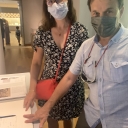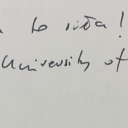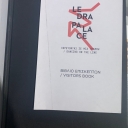On 20th July 2021, a six-person representation of the Department of Computer Science of the Lublin University of Technology visited the CYENS Centre of Excellence research site in Nicosia, Cyprus. There was a meeting with the authorities of the research centre, with Prof. Yiorgos Chrysanthou, Research Director and Dr Olga Shvarova, Chief Innovation Officer. Dr Andreas Aristidou presented the laboratories located in the centre: Conventional motion capture laboratory and Psychophysics lab and interaction design. Scientists from the Lublin University of Technology had the opportunity to learn about the research teams working there and the research issues and projects currently being carried out by them. Scientists from CYENS presented a modern 24-camera motion capture system (Capture System Impulse X2E) by Phasespace Inc., as well as work carried out with the use of XSense and Microsoft Kinect equipment.
Employees of the Lublin University of Technology and the CYENS Centre of Excellence research site presented their units and the research carried out there. CYENS employees presented research on Greek dances, costumes, and dancers’ facial expressions. Scientists from the Lublin University of Technology presented the results of their research in the field of material culture, in particular 3D scanning of museum objects, processing of acquired data and digital reconstruction, as well as the creation of panoramas created by 3D scanning of architectural objects. They also presented the website “3D DIGITAL SILK ROAD” (silkroad3D.com). The possibilities of future cooperation between the Lublin University of Technology and the CYENS centre in the areas of traffic acquisition, 3D scanning and digitisation of cultural heritage were discussed.
Scientists from the Lublin University of Technology also visited the Leventis Municipal Museum of Nicosia, where they could learn about Greek culture in the form of a collection of Cypriot works, including archaeological artefacts, costumes, photographs, mediaeval ceramics, maps and engravings, jewels and furniture. The museum includes scanned elements of Greek culture and a Virtual Reality system made by employees of the CYENS centre.


